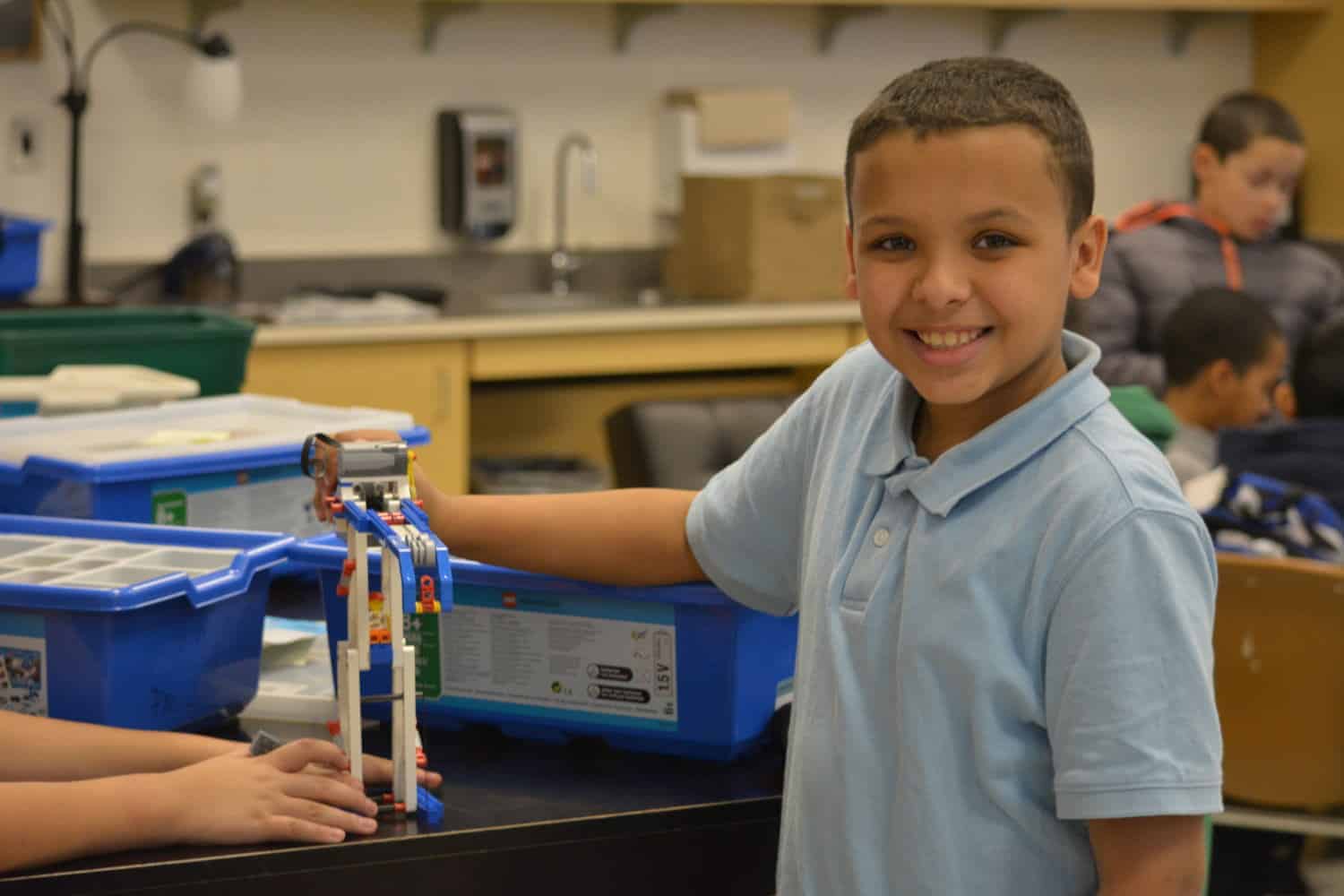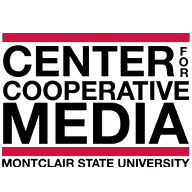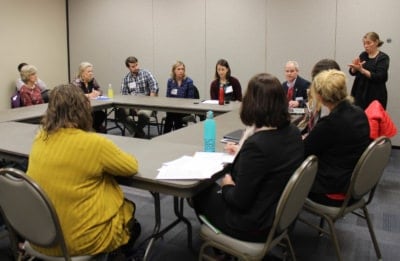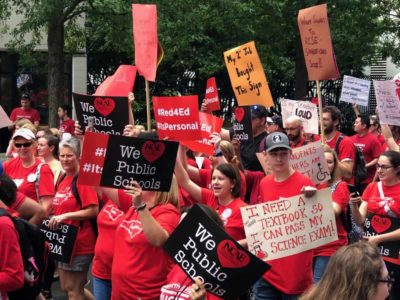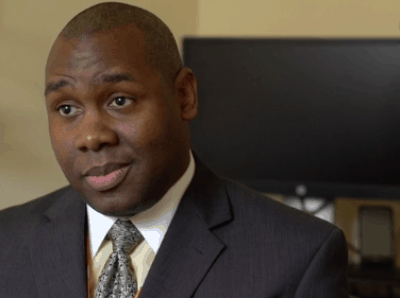This case study was published by the Center for Cooperative Media and written by Phil Corso. Corso is an editor, educator and journalist from Brooklyn, NY.
Restart was a little known state education program affecting more than 100 schools in North Carolina. But two reporters at competing news outlets in the state kept wondering what the program was about, and if it was really effective. That led them to team up last year in a special collaboration, talking not only to educators, parents and students, but lawmakers and taxpayers as well.
Their in-the-weeds reporting helped shine a light on the program and brought up questions about whether it was working or not.
EducationNC reporter Alex Granados and WRAL TV data reporter Kelly Hinchcliffe agreed to work together in the summer of 2017 to delve into North Carolina’s Restart program, which gave the lowest performing schools more charter-like flexibility, allowing them to experiment to enhance student performance.
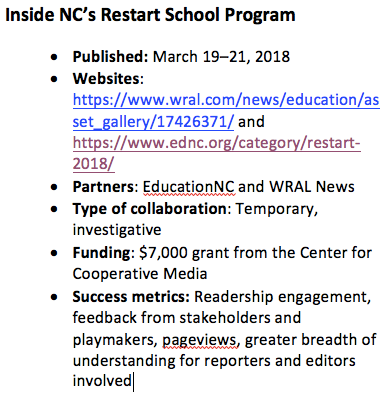
They raised important questions about the lack of accountability of the program, and in the process enhanced their beat expertise as reporters and helped their respective outlets to better serve their audiences. The in-depth series included text reports, videos, data visualization, a podcast and even an audience survey.
“I feel like a collaboration like this illustrates that what’s most important is the news — and not who does it,” said Granados, who started working with EducationNC at its inception in 2014. “When news organizations can set aside competition and work together, they get the information people need, and that’s good for everybody.”
Different outlets, But Similar Goals
Though they were competitors covering the same education meetings, Granados and Hinchcliffe said they approached their craft differently by keeping readers in mind. They eventually teamed up on projects such as interviewing a new state schools superintendent with their employers’ blessing. And by 2017, the two had developed enough of a trust and rapport that they were learning how each other’s strengths could make collaborative story pitches work.

“Most of our work is still separate from one another,” Hinchcliffe said. “But in the North Carolina education press corps, we have a lot of respect for each other. We’re still supportive of one another. A lot of times, we have similar ideas for stories that we want to cover in-depth.”
Granados said his organization, EducationNC, had a focus on collaboration from its outset. And since he and Hinchcliffe were covering the same education meetings on a monthly basis, they developed a rapport over time and quickly learned they had chemistry in both their understandings of the topics and their complementary strengths as journalists.
So Granados approached Hinchcliffe to see what kind of work they could get done together, culminating in several different journalistic collaborations over the years.
“We see the mission as getting information about education out there. And whether it’s us, or somebody else, doesn’t matter to us as much as it does the public having the information,” Granados said. “We see collaboration as an extension of that. We’re not worried about it being our sole product.
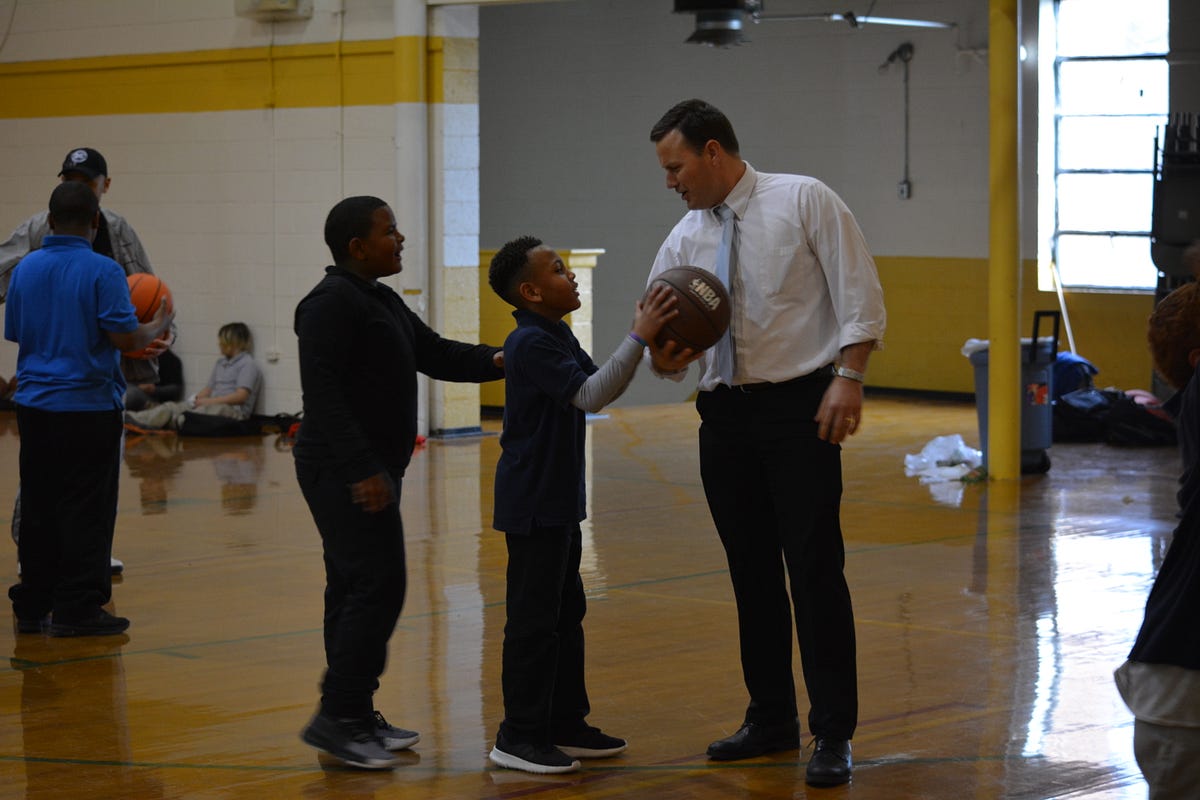
While they still work independently most of the time, Hinchcliffe said she and Granados have a lot of respect and support for one another. Collaboration, though, was something new for her station, she said. It was also an idea that she said her bosses welcomed with open arms.
The reporters developed the series idea together while covering state board of education meetings for their respective outlets. The topic of Restart schools kept popping up, meeting after meeting, and setting off alarm bells in both reporters’ minds. What they found was that schools were slowly becoming aware of a state statute that many wrongfully thought was defunct, and more than 100 of them had started applying for and receiving Restart status by the middle of last year.
That’s in part what spurred Granados, who works for the non-profit EducationNC news startup, to apply for a $7,000 grant via the Center for Cooperative Media, which helped them and five other collaboration projectspublish their work in late 2017 and 2018 thanks to funding from the Rita Allen Foundation and Democracy Fund.
Educating lawmakers
Granados said that both he and Hinchcliffe, an 11-year WRAL veteran with a knack for data and public record research, would discuss the repetitive applications and sought to investigate the phenomenon and what it meant about the future of education in their state.
“North Carolina is usually a very top-down education state,” he said. “Policy gets made by the General Assembly and filters down to the school systems. But this wasn’t happening. This was schools taking their own initiative and it looked like a different process by which statewide policy was taking place.”
What they were realizing, the reporter said, was that even the state’s top lawmakers didn’t know much about the program.
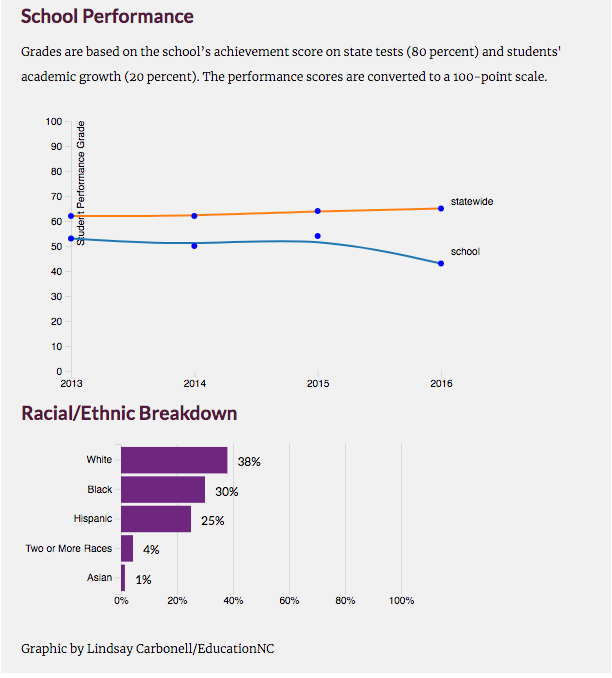
Their stories investigated just how much the program’s charter-like flexibility was helping the more than 100 schools taking part in the program across the state. It illustrated opposing viewpoints between lawmakers and school officials, with some singing the program’s praises and others being more skeptical of its potential. But because a lot of the results were still to be determined, the bulk of their reporting was explanatory, describing the nuts and bolts of the program and putting stakeholders on the record about it.
“We approached it from a perspective of, ‘What is this thing? How does it work?’” Hinchcliffe said. “The people we spoke with — even people at the top — had questions about it.”
Laura Lee, who works as an editor at EducationNC, said her team was always on the lookout for collaboration with community groups or other media outlets and that this particular project was perfect because it involved exploring several schools across the state. She said the project showed how collaborative work can give greater depth to reporting and demonstrates how solid, thorough reporting can be shared in different formats to reach wider audiences.
“I think the collaboration went really well,” she said. “Alex and Kelly have worked together on other projects prior to the Restart series, so they understand each other’s work styles, sourcing strengths and reporting abilities.”
Working as a team
The two reporters set out to visit as many schools as they could, given the time and resources available to them while they still covered other stories for their news outlets. They utilized each reporter’s greatest strengths to divvy up the workload and hit the ground running. Granados used his connections with state legislators to get the policy angle, while Hinchcliffe interviewed educators and school officials to round out the information gathering.
“We checked in pretty often and were both good motivators for each other,” Granados said. “We had regular check-ins, asking ‘What do we have so far? What do we need?’”
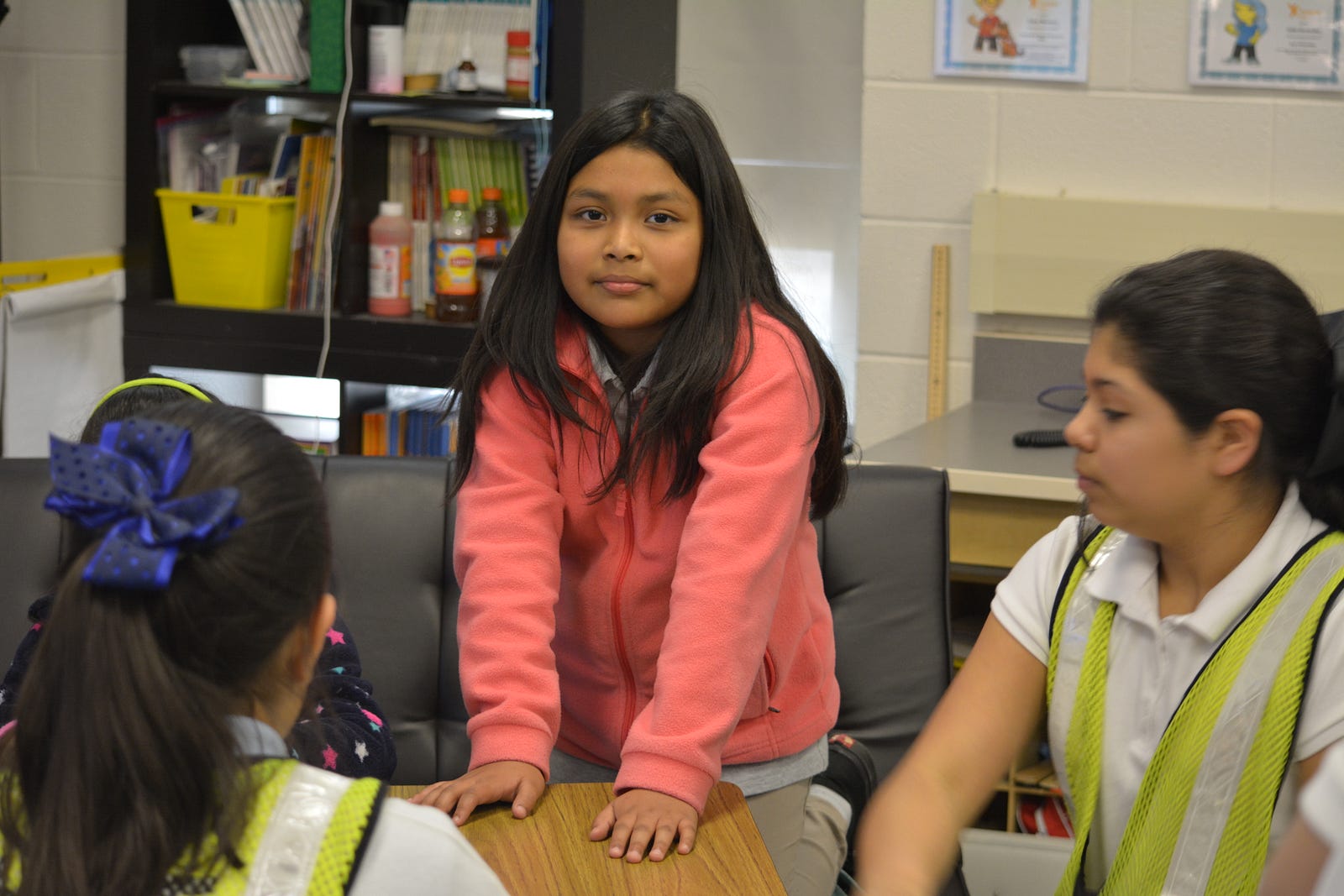
They kept most of their notes and communications on a shared Google Doc for safekeeping and wrote their respective parts of the three-part series there, leaving notes like “Can you explain this more?” and “I’d like to add something here” on each other’s reporting to answer questions that arose throughout the process.
“We took different leadership roles on each of the three stories,” Hinchcliffe said. “One, Alex would take the lead on, since most of it dealt with what he interviewed people about, for example. But we wrote all three of them together.”
While the idea for the project sprouted up in the summer of 2017, and the grant funding helped push them forward by last fall, the pieces were finally published in March 2018 on the same days on both news outlets. Granados paid a visit to WRAL to do a guest spot with Hinchcliffe to discuss the stories on the air.
WRAL News Editor David Hendrickson, whose first day on the job was the day the reporters turned in their copy, helped edit the final product, while Lindsay Carbonell of EducationNC worked with the reporters to create the graphic elements that accompanied the published pieces.
Collaborative reporting with results
“We measure success in several ways,” said Lee, who deemed the collaboration a success because it offered traditional text stories, but also other multimedia content including data visualization, video and a podcast. “One way we measure it is through our reach; the series performed well on our site, but Alex and Kelly also had the opportunities to share the content beyond our regular audiences. They appeared on public radio programs, and other outlets, including the Hechinger Report, and shared the content.”
Aside from being happy with the finished product, both outlets said the fact that the topic received a healthy dose of sunlight was enough of a reason to consider the collaboration an overall success.
“I think anything that encourages journalists to do more in-depth reporting is good,” Hinchcliffe said. “I love that when we go to do interviews, we can tell sources that we want to sit down with them, or be in their school all day and not just sit down for five minutes. I want to come back multiple times. People appreciate that we are going to spend the time.”
Lessons learned
We asked members of both EducationNC and WRAL’s newsrooms to share some of the key lessons they learned from the collaboration that made them more efficient and effective. Here’s what they said:
Alex Granados, reporter, EducationNC:
While Granados has been covering education in North Carolina for years, he said this was the first time he had applied for a grant himself based off an idea that sprouted in his own brain. Because of this, he was cognizant of every detail throughout the project because he knew his reputation was on the line through to the very end.
“It was … my first collaboration that was multi-faceted,” he said. “Other ones were mostly one-offs. But this one ended up being much more complicated and complex.”
As for learning more about collaborative journalism, he said that personnel management was key.
“A key lesson, which I learned from Kelly, is that you have to collaborate with someone you get along with. It’s about matching with the right people,” he said. “The two of us had separate focuses within education, even though we do cover a lot of the same stuff. There are areas we focus more on independently, and we brought those perspectives to the table.”
But as much as he valued working together, Granados also said that trusting your collaborators to do the right thing on their own was also essential.
“In our role as journalists, we both have a lot of independence in what we do,” he said. “We’re both accustomed to making our own decisions and making things happen on our own. It was helpful to have a like-minded person working with me throughout the process.”
Kelly Hinchcliffe, data reporter, WRAL News:
WRAL News Reporter Kelly Hinchcliffe said she learned a lot about how the donuts got made by collaborating with EducationNC, particularly in the graphics department.
“With my interest in data and public records, there was a question about turning some of that data into graphics,” she said. “I was double-checking some things, and the numbers didn’t look right to me. I called a source of mine in the state education department and was able to figure out that the numbers were, in fact, correct. It was an example of how we used our strengths throughout the project.”
She learned a lot from working with the EducationNC graphics editor, she said, and also learned that, at times, email and phone just weren’t good enough.
“I learned a lot from the graphics side of the project. I don’t physically work with the graphics designer we collaborated with. I would email her a lot for fixes and changes. But I realized that it was way too many emails. If given another chance, I would have changed the way we communicated about something so visual. Email and phone can only go so far.”
It was her first time working on a project funded by a journalistic grant, she said, which also taught her a lot about the legalities of the process and also inspired her to consider seeking more of the same kind of work on her own.
“It was interesting to see how that process worked and makes me want to apply for similar grants myself, so I can have more time to focus on stories like this and do more collaboration,” she said. “It cemented for me how much I enjoy working with reporters like Alex.”
Laura Lee, editor, EducationNC:
EducationNC editor Laura Lee said her belief that a better product can be created if once-competing organizations joined together was reinforced through this story.
“I think one of the key lessons learned is the value of a strong working relationship between collaborating organizations,” she said. “A joint project can’t be two independently working entities; it really requires step-by-step collaboration.”
She said there were certain things that were necessary for the lead reporters in order to make sure the finished product was well-rounded, and not an untethered mess after months of reporting and hundreds of interviews and meet-ups.
“The project was successful in large part because of their open lines of communication,” she said. “One of the challenges, as is so often the case in our field, was time constraint. We worked to set some internal deadlines at both organizations to make sure we had ample time to bring all the work together in the final version of the series.”
This project was awarded a $7,000 grant by the Center for Cooperative Media as part of an open call to fund collaborative reporting project, which was made possible with support from Rita Allen Foundation and Democracy Fund.
Phil Corso is an editor, educator and journalist from Brooklyn, NY. He has worked with outlets including the New York Post, New York Daily News, amNY, Westchester Magazine and more. He’s also worked as a professor of journalism at Queens College and advised journalism students at Purchase College, his alma mater.
About the Center for Cooperative Media: The Center is a grant-funded program of the School of Communication and Media at Montclair State University. The Center is supported with funding from the John S. and James L. Knight Foundation, the Geraldine R. Dodge Foundation and Democracy Fund. Its mission is to grow and strengthen local journalism, and in doing so serve New Jersey residents. For more information, visit CenterforCooperativeMedia.org.
